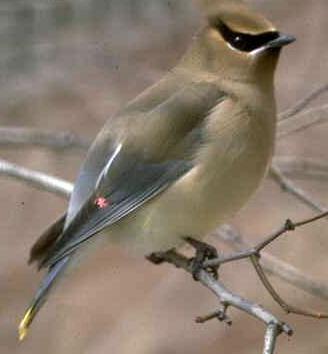Waxwing - Cedar
Cedar Bird, Canada Robin Scientific Name: Bombycilla cedrorum
Sat, 19th July, 2025 - 2:49 am GMT
Sponsor Ads:

Alternative Name
Cedar Bird, Canada Robin Scientific Name: Bombycilla cedrorumBasic Info
The Cedar Waxwing is a fascinatingly northern-American bird, with the color scheme to match. It has a brown upper body. A black mask covers its eyes, running from the edge of the bill to back behind the eyes. The wings are a dark color, with the edges of the feathers having small red tips, the tail feathers having yellow tips. The Cedar Waxwing also sports a crest. Their bills are thin and short. The Cedar Waxwing is smaller than the Robin, averaging six and a half to eight inches in length, with females being a little smaller than males. The Cedar Waxwing is sometimes confused with the Bohemian Waxwing, but they can be differentiated by the Bohemian's gray belly, yellow and white plumage under the wing and dark covets under the tail.
Health
If you want to attract Cedar Waxwings, you'll need to be living in either central or northern America for most of the year. Keep an ample supply of berries on hand, they'll flock to those - but be warned, they'll go through them really fast. So either keep a lot of berries around or be prepared to only see them for a short time. They also enjoy a birdbath just as much as the next fowl; keep a fresh, clean one around and they'll flock to it. The Cedar Waxwing is particularly attracted to forest edges and woodlands. Breeding Breeding season begins in May, and ends in late August. Cedar Waxwings prefer nesting in Conifer trees, and the female will lay a clutch of five or so pale blue, darkly spotted eggs, that will incubate for 12 days. The male's role in this is mostly unknown; this bird's mating habits haven't been documented much. They are cared for after hatching by the parents for about 16 days. The Cedar Waxwing's nest is made from weed stalks, twigs, dried grasses, pine needles, mosses, and sometimes material taken from the nests of other birds! During mating season these birds become so tame they are known to take string people's hands.Habitat
N/ABehavior
A quiet, solitary bird, the Cedar Waxwing is known for its excellent hunting skills, and its tendency to show off, making it a fascinating species to watch for any potential bird watcher. Cedar Waxwings, also known as Canada Robins and Cedar Birds are a fascinating species to watch, given their quiet nature. They have a very soft voice - if you can hear their song, it's only a very soft trilling, and even then, it is fairly hard to hear. The Cedar Waxwing travels in groups, staying close together as they search for food. Summertime is bug-hunting time, because insects tend to swarm over pools of water, making them large feeding areas for the Cedar Waxwing. They have a special liking for berries, and they will eagerly strip a vine of its precious cargo in minutes, since they travel in groups and can attack a vine from all sides, rending it empty quickly. During the harsh winter seasons, Cedar Waxwings will migrate south to warmer climates where they can continue breeding and feeding until it's time to return to the north. They prefer forest edges for nesting, and will make a nest out of twigs, leaves, and dry grasses, making a heavily lined cup to lay eggs in. The Cedar Waxwing is definitely an interesting bird to watch. If you can find an area with grapevines, and the grapes have fermented, the Cedar Waxwing group will strip the vine and promptly get drunk! You can observe them doing lazy flips backwards and tossing about lazily in the air. Who knew the Cedar Waxwing was a bit heavy on the bottle? Also, they're called "waxwings" because in adults, the feathers emit a bright red substance that creates dark red spots on the wings, and it looks like wax seals of the old days, hence the name.Origin
North AmericaHistory
The Cedar Waxwing lives primarily along the United States -Canada border, though it is also seen in parts of Central America.Common Foods
They have a varied diet, feeding mostly on insects, berries, maple sap and small fruits. During the summer, they are adept insect hunters.Sponsor Ads:
"So much has been lost, so much forgotton. So much pain, so much blood, and for what, I wonder? The past tempts us, the present confuses us, and the future frightens us. And out lives slip away, moment by moment, lost in that vast terrible inbetween. But there is still time to sieze that one last fragile moment. To choose something better. To make a differance." -- Centauri Emperor on last visit to B5 - Babylon 5
Waxwing - Cedar
Coded by: BGID® | ALL RIGHTS RESERVED Copyright © 2000-2025
Disclaimer | Privacy | Report Errors / Contact | Credits








 Preparing For China. China is growing their military. China Military Technology - can it keep up with the US?
Preparing For China. China is growing their military. China Military Technology - can it keep up with the US?  versus
versus 

 versus
versus 
 This Thread is about the North Korean Military itself - the kind of army, navy, and air force they have.
This Thread is about the North Korean Military itself - the kind of army, navy, and air force they have. 
 versus
versus 
 versus
versus  versus
versus